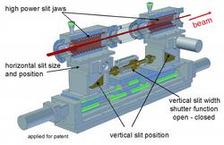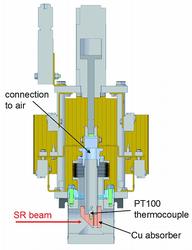Figure 1: High power slit system and photon shutter for PETRA III undulator beamlines.
The conversion of the PETRA storage ring into a brilliant hard X-ray light source poses challenges to the design of the beam line transport system. One of these challenges is to supply 14 beamlines with the extremely collimated undulator radiation while fulfilling the stringent personal safety requirements combined with easy con troll ability. In order to access beamlines and experiments while the machine is operating, the undulator beam and the Bremsstrahlung background have to be blocked inside the storage ring tunnel. This is achieved by a combination of a primary photon shutter (PS) and a secondary beam -shutter (BS) which are both controlled by the personal safety interlock. The direct undulator beam with its high power density is stopped by the PS which is the main component of the machine protection system. A fail-safe operation of the PS is mandatory to avoid any damage of the BS, which is the critical component of the radiation safety system. In order to achieve this in an easy controllable way, a so-called „sacrificial absorber“ is inserted between PS and BS to detect a not fully closed PS.
The high power photon shutter (Fig. 1) is designed as a slit system which additionally acts as an absorber to block the direct undulator beam. The upper and lower jaws consist of an inclined water-cooled absorber - made out of GlidCop® - which accepts the primary beam power.
The cooling channels are machined to wind in a spiral around the central copper block which is brazed into a stainless steel body. A tungsten disk behind the jaw serves to absorb most of the highly energetic X-rays thereby also reducing the background radiation at the experiment. The slit jaws are being adjusted by horizontal slides combined with two coupled wedge-driven lifting tables. The centre slide controls the slit width by driving a pneumatic cylinder, which is part of the coupled drive for the lifting tables and controls the “open” and “closed” state of the slit system. The two outer slides are horizontally moved by a left-right hand spindle translated by the wedges into a vertical motion of both slits.
Obviously, the precision of this combined vertical movement is critical regarding the roll angle around the beam axis. This quantity was measured independently for both jaws during travel using autocollimator systems (Fig. 2 right), proving that the stringent specifications are fulfilled. The additional shutter function of the device is achieved by the integrated pneumatic cylinder (see Fig. 1). The overlap of the slit jaws in the closed state (~1mm) is critical for the thermal protection of the downstream beamshutter. Any condition of non-fully overlapping slits has to be detected in a simple fail-safe way.
This requirement is realized using a sacrificial absorber in front of the BS which is moved into the beam before the BS is permitted to close. A cross section of the sacrificial absorber is shown in Fig. 3. It consists of a Cu absorber brazed on a pipe connected to air. A bellow allows to move the sacrificial absorber into the beam. In a worst case scenario, the PS is not fully closed and the undulator beam would hit the copper block of the sacrificial absorber and ultimately burn a hole into it. This would cause venting of the beamline and consequently stop the beam operation before the BS is damaged. While this procedure is fail-safe, it is of course not the desired scenario.
In order to detect a non-closed PS before melting the sacrificial absorber, the absorber temperature is monitored by a thermocouple which will trigger an opening of the undulator in case of a suspicious temperature increase. In order to precisely calibrate the time constants of the temperature rise, test experiments were carried out at the undulator beamline ID6 of the ESRF using a fast photon shutter for precise timing. Based on these data, it can be proven that there is sufficient time for the undulator to reach a powerless state before the temperature of the absorber becomes too high.








